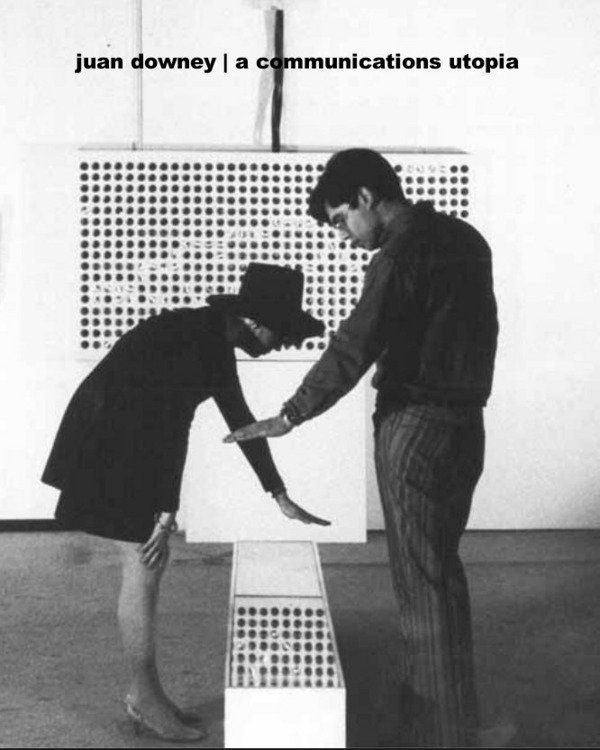Juan Downey
dal 20/3/2013 al 31/8/2013
Segnalato da
20/3/2013
Juan Downey
Museo Tamayo Arte Contemporaneo, Mexico City
A communications utopia. His work covers a wide range of practices and mediums: drawing, installation, video, and painting. The exhibition presents a significant selection from his major bodies of work, taking as a point of departure the notion of feedback as a constant and structural aspect.

Curator Julieta González
The work of Juan Downey (Santiago de Chile, 1940 – New York,
1993) covers a wide range of practices and mediums: drawing,
installation, video, and painting. Likewise, it addresses a series of
complex issues, very current at the time, about the use of new
technologies in art and the implications this would have in terms
of its reach and production of meaning in a context that went far
beyond the museum and gallery exhibition space.
The exhibition Juan Downey. A Communications Utopia presented
at the Museo Tamayo presents a significant selection from his major
bodies of work, taking as a point of departure the notion of feedback
as a constant and structural aspect of his work throughout his
entire production.
Juan Downey was a pioneering figure of video art in a moment in
which the medium was just beginning to be utilized by artists, who
saw in it an enormous potential; the communicative power of the
television medium, the immediacy of its transmission, its closed
circuits and its manifold possibilities of edition and feedback, lent
themselves to multiple experiments, not only in terms of image but
also of perception and communication.
Trained as an architect, the topological experience of video feedback
led Downey to conceive of dematerialized and ecological architectures
through drawings of projects for buildings and cities that promoted
the flow of energy between nature and the built environment.
One of Downey’s landmark works is the video-feedback-based
installation Video Trans Americas. In 1973 he embarked on a journey
that would take him from New York to Mexico, Guatemala, Peru,
Bolivia, and Chile, where he recorded the autochthonous cultures of
each place and then showing them to the inhabitants of these places
and to others during the trip. Later, Downey decided to travel to
the Venezuelan Amazonian basin and resided there, among the
Yanomami, producing one of the most singular bodies of work in
recent art history. With these fundamental works, Downey positions
himself as a “cultural communicant, an activating aesthetic
anthropologist with a visual means of expression: video tape.”
Upon his return to New York, at the end of the seventies and until
his death in 1993, Downey continued to make videos that reflected
on mass culture, the media, and representation, reaffirming his
continued interest in communication structures.
Downey’s cybernetic utopia proposed a radical reformulation of
the relations between man and technology, made manifest in the
selection of works included in this exhibition, which presents Juan
Downey as a thinker, of visionary and advanced ideas, aware of the
complexities of his time.
Juan Downey (Santiago, Chile, 1940 - New York, 1993)
He studied architecture at the Pontificia Universidad Católica de
Chile. After college he moved to Paris where he lived for a period
of three years. While in Europe he met artists such as Eugenio
Tellez, Roberto Matta, Vassilakis Takis and Julio Le Parc. In 1965
he was invited by the Organization of American States to exhibit
his work in Washington, a city where he lived for a couple of years.
Finally, he would permanently move to New York where he lived
until his death in 1993.
Image: Juan Downey and unidentified person in front of Information Center at the gallery
Howard Wise, 1970. Photo: Harry Shunk / Cortesía Marilys Belt de Downey, N.Y.
Communications
Sofía Provencio - Beatriz Cortés T. (5255) 5286 6519 prensa@museotamayo.org
Museo Tamayo Arte Contemporáneo
Paseo de la Reforma 51, Bosque de Chapultepec Del. Miguel Hidalgo C.P. 11580. México, D.F.
Hours:
Tuesday through Sunday, 10 am to 6 pm
Price: $19 / General public
Entrance is free to students, teachers, and senior citizens with valid identification
Sunday free to public



